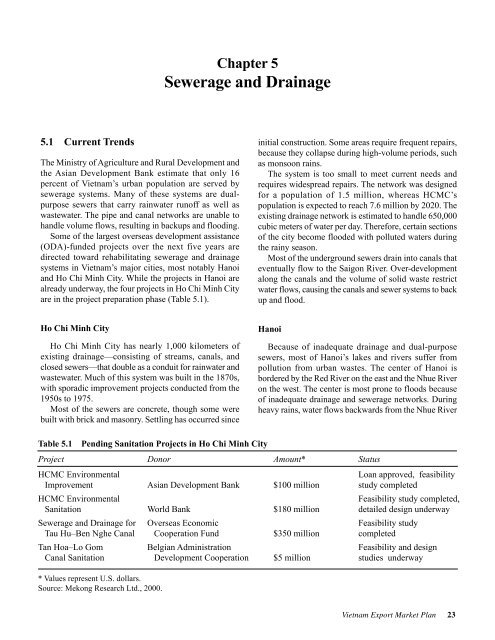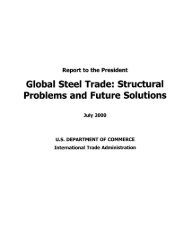Vietnam Environmental Technologies Export Market Plan
Vietnam Environmental Technologies Export Market Plan
Vietnam Environmental Technologies Export Market Plan
Create successful ePaper yourself
Turn your PDF publications into a flip-book with our unique Google optimized e-Paper software.
Chapter 5<br />
Sewerage and Drainage<br />
5.1—Current Trends<br />
The Ministry of Agriculture and Rural Development and<br />
the Asian Development Bank estimate that only 16<br />
percent of <strong>Vietnam</strong>’s urban population are served by<br />
sewerage systems. Many of these systems are dualpurpose<br />
sewers that carry rainwater runoff as well as<br />
wastewater. The pipe and canal networks are unable to<br />
handle volume flows, resulting in backups and flooding.<br />
Some of the largest overseas development assistance<br />
(ODA)-funded projects over the next five years are<br />
directed toward rehabilitating sewerage and drainage<br />
systems in <strong>Vietnam</strong>’s major cities, most notably Hanoi<br />
and Ho Chi Minh City. While the projects in Hanoi are<br />
already underway, the four projects in Ho Chi Minh City<br />
are in the project preparation phase (Table 5.1).<br />
initial construction. Some areas require frequent repairs,<br />
because they collapse during high-volume periods, such<br />
as monsoon rains.<br />
The system is too small to meet current needs and<br />
requires widespread repairs. The network was designed<br />
for a population of 1.5 million, whereas HCMC’s<br />
population is expected to reach 7.6 million by 2020. The<br />
existing drainage network is estimated to handle 650,000<br />
cubic meters of water per day. Therefore, certain sections<br />
of the city become flooded with polluted waters during<br />
the rainy season.<br />
Most of the underground sewers drain into canals that<br />
eventually flow to the Saigon River. Over-development<br />
along the canals and the volume of solid waste restrict<br />
water flows, causing the canals and sewer systems to back<br />
up and flood.<br />
Ho Chi Minh City<br />
Ho Chi Minh City has nearly 1,000 kilometers of<br />
existing drainage—consisting of streams, canals, and<br />
closed sewers—that double as a conduit for rainwater and<br />
wastewater. Much of this system was built in the 1870s,<br />
with sporadic improvement projects conducted from the<br />
1950s to 1975.<br />
Most of the sewers are concrete, though some were<br />
built with brick and masonry. Settling has occurred since<br />
Hanoi<br />
Because of inadequate drainage and dual-purpose<br />
sewers, most of Hanoi’s lakes and rivers suffer from<br />
pollution from urban wastes. The center of Hanoi is<br />
bordered by the Red River on the east and the Nhue River<br />
on the west. The center is most prone to floods because<br />
of inadequate drainage and sewerage networks. During<br />
heavy rains, water flows backwards from the Nhue River<br />
Table 5.1 Pending Sanitation Projects in Ho Chi Minh City<br />
Project Donor Amount* Status<br />
HCMC <strong>Environmental</strong><br />
Loan approved, feasibility<br />
Improvement Asian Development Bank $100 million study completed<br />
HCMC <strong>Environmental</strong><br />
Feasibility study completed,<br />
Sanitation World Bank $180 million detailed design underway<br />
Sewerage and Drainage for Overseas Economic Feasibility study<br />
Tau Hu–Ben Nghe Canal Cooperation Fund $350 million completed<br />
Tan Hoa–Lo Gom Belgian Administration Feasibility and design<br />
Canal Sanitation Development Cooperation $5 million studies underway<br />
* Values represent U.S. dollars.<br />
Source: Mekong Research Ltd., 2000.<br />
<strong>Vietnam</strong> <strong>Export</strong> <strong>Market</strong> <strong>Plan</strong><br />
23
















